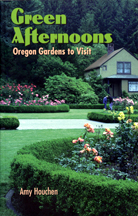
Green Afternoons
Amy Houchen
Illustrations by Lee Hascall.
With Green Afternoons in hand, travelers, gardeners, and plant enthusiasts now have an exciting new guide to more than six dozen gardens throughout western and central Oregon and southwestern Washington.
In her tour of the region, Amy Houchen uses the word "garden" broadly to include not only traditional gardens but also plantings of interest in such places as parks, college campuses, farms, and community gardens. Along with providing detailed descriptions of Oregon's best known and best loved gardens, Green Afternoons introduces readers to such unlikely but rewarding spots as an arboretum at a freeway rest area and climbing roses dressing up the cyclone fence around a ballfield.
Arranged geographically, the garden listings include
- seasons of interest,
- directions,
- whether plants are labeled,
- a section on background and history,
- and a description of what to see.
Indexes by plant name and topic allow for ease in locating plant specialties and such features as gardens for the blind and composting exhibits. Also included is information on holding weddings and listings of special events.
From the Hulda Klager Lilac Gardens in Woodland and the International Rose Test Garden in Portland's Washington Park to Shore Acres in Coos Bay and the Sunriver Botanical Garden, Green Afternoons offers an informative and easy-to-use guide for locating and learning about the region's most beautiful gardens.
About the author
Amy Houchen writes on gardens and gardening from her home in Portland, Oregon.
Read more about this author
Introduction
- Portland North of Burnside and Communities to the North
- The Grotto
- The Oregon Garden
- Peninsula Park
- University of Portland
- Bybee-Howell Territorial Park, Sauvie Island
- Columbia County Demonstration Garden, St. Helens
- Hulda Klager Lilac Gardens, Woodland, Washington
- Salmon Creek Poison Prevention Garden, Vancouver Washington
- Fort Vancouver, Vancouver, Washington
- Southeast Portland and Southern and Eastern Suburbs
- Ladd Circle and Squares
- Crystal Springs Rhododendron Garden
- Leach Botanical Garden
- Gresham Regional Library Japanese Garden
- Mt. Hood Community college, Gresham
- The Gardens of Enchantment, Sandy
- Heritage garden, Oregon City
- Oregon City - Tateshima Sister City Japanese Garden, Oregon City
- Clackamas Community College, Oregon City
- Southwest Portland and Washington County
- Duniway Park
- Elk Rock
- The Berry Botanic Garden
- Edna Holmes Garden
- Fulton Display Garden
- The Jenkins Estate, Aloha
- Harold Eastman Memorial Rose Garden, Hillsboro
- Washington Park
- International Rose Test Garden
- The Japanese Garden
- Hoyt Arboretum
- Metro Washington Park Zoo
- OMSI Herb Garden
- Northern Willamette Valley
- Emma Wakefield Herb Garden, Aurora
- North Willamette Experiment Station, Aurora
- The Grove of the States, Wilsonville
- The Cecil and Molly Smith Garden, St. Paul
- Minthorn House, Newberg
- Linfield College, McMinnville
- Salem-Dallas Area
- Capitol Arboretum, Salem
- Willamette University, Salem
- Deepwood, Salem
- Bush's Pasture Park, Salem
- Brunk House, Salem
- Delbert Hunter Arboretum and Botanic Garden and Japanese Garden, Dallas
- Western Oregon State University and Gentle House, Monmouth
- Corvallis-Albany Area
- Albany Olde-Fashioned Garden
- Peavy Arboretum, Corvallis,
- Chintimini Park, Corvallis
- Oregon State University, Corvallis
- Central Park, Corvallis
- Avery Park, Corvallis
- Lewis-Brown Farm, Corvallis
- Eugene
- Owen Rose Garden
- University of Oregon
- Hendricks Park
- Mt. Pisgah Arboretum
- Southern Oregon
- Lotus Knight Porter Garden, Roseburg
- Roseburg Veterans' Administration Hospital
- Douglas County Demonstration Farm, Roseburg
- Victor Boehl Memorial Rose Garden, Grants Pass
- Palmerton Arboretum, Rogue River
- Jacksonville Herb Garden
- Old Rose Garden, Jacksonville
- Southern Oregon Experiment Station and Claire Hanley Arboretum, Medford
- Lithia Park, Ashland
- The Coast
- Tillamook Master Gardeners' Demonstration Garden
- The Connie Hansen Garden, Lincoln City
- Gallagher's Park, Florence
- Mingus Park, Coos Bay
- Shore Acres, Coos Bay
- Central Oregon
- Seufert Rose Garden, The Dalles
- Rorick House, The Dalles
- Sorosis Park, The Dalles
- Kalama Park, Redmond
- Pioneer Park, Bend
- Hollinshead Garden, Bend
- Sunriver Botanical Garden
- Gardens in the Works
- Classical Chinese Garden, Portland
- Sara Hite Memorial Rose Garden, Milwaukie
- The Oregon Garden, Silverton
- Jackson & Perkins Garden at Miles Field, Medford
- Pioneer Garden, The Dalles
- Japanese Garden, Four Rivers Cultural Center, Ontario
General index
Plant index
Gardeners visit gardens other than their own for various reasons: instruction, inspiration, reflection, respite from the demands of their won gardens, communion with kindred spirits. This book is for those who want to know where to find gardens to visit without a special invitation from the owner. All the gardens listed here (except, of course, those in the works) are, at this time of writing, reasonably accessible to the public. They may be open every day, at all hours, or only a few days during the season when their specialty is at its best, or for some other limited period, or by appointment. Admission may be free, a set charge, or by donation. hours and admission policies change occasionally, so it's a good idea to call ahead and make sure the garden will be open when you want to see it.
This book uses the term "garden" broadly, to include not only traditional, stand-alone gardens but also plantings of interest in such places as parks, college campuses, farms, and community gardens. It includes an arboretum at a freeway rest area, old-fashioned flowers planted in the island of a visitor center parking lot, climbing roses dressing up the cyclone fence around a ballfield, and a display of ornamentals at an agricultural experiment station.
All but three of the gardens are in Oregon. Those three--Fort Vancouver and Salmon Creek in Vancouver and the Hulda Klager Lilac Garden in woodland, Washington--seemed too close to Portland, and too interesting, to leave out.
Some garden descriptions are long, some are short. They may be short for various reasons. some gardens are very small; some change annually; some are very simple in design or planting; for some, no one would claim knowledge of the plantings. All should be of interest to at least some readers. The descriptions are intended to give a flavor of the gardens, not to list every plant. If you want to know whether a particular species or cultivar is grown in a garden, call ahead. Where telephone numbers are listed with a parenthetical reference, the number is not that of the garden but of the person or entity that can respond to inquiries about the garden.
You may be glad to travel a few miles to see a garden that you would not drive hours to visit. Many of the gardens are quite modest in size and scope--herb gardens, in particular, are tiny--so read the descriptions carefully before you go. Some very small gardens were included because they show how to use a small space well.
The garden listings include seasons of interest, directions, public transit information (in the Portland area), information on holding weddings, whether plants are labeled, a listing of special events, a description of what to see, and a section of background. Any gardener knows that gardens don't just happen. They get started for a reason; someone determines their site, shape and scope; and someone keeps them going. Some of the gardens started as estates or personal hobbies; others were begun by plant societies, or restored and made accessible tot he public by historical-interest groups. Some were founded as educational tools, and some are part of the public face of institutions. Most, but not all, of the Oriental gardens were begun by or in conjunction with sister-city organizations.
Specialty collections, including roses and herbs, may be worth a trip to those especially interested in them even if they are not the main focus of a garden. Some gardens are of interest in only one or two seasons; others are rewarding all year long. Unless the garden has a conservatory, witch hazels, camellias, or species rhododendrons, it won't have much color in winter, even though it may well be worth seeing them for evergreens and the branch structure of deciduous plants.
Change occurs in all gardens. Plants grow, change, and die; tastes change; physical and financial circumstances alter. Varieties come and go; few gardens are as fortunate as the International Rose test Garden in Washington Park, which can count on a body of volunteers to keep treasured old varieties in propagation although they're no longer available commercially. Gardens disappear: Lambert Gardens got built upon, and Monteith Riverpark lost its rose garden because it became too shady. Nature wreaks havoc: many gardens suffered losses in the Columbus Day Storm (an offshoot of Typhoon Frieda that swept through western Oregon and Washington, bringing high winds, on October 12, 1962); the unusual snow and cold during the winter of 1988-89; the storms during the winter of 1995-96 that brought wind, then cold, then ice, then floods and landslides; and the ice and snow late in 1996. New gardens are planted. Change means that this book is slightly out of date even as it is printed.
Gardens all require time, money, and effort. Funds for gardens run by public entities have been cut severely as other public concerns shouldered them aside in the budget process. If you have a particular interest in or fondness for a garden, it probably has a group of friends that would welcome your time, money, effort, or all three, to ensure its continuation and good health. Gardens don't thrive on neglect.
Finally, when you visit these gardens, take care to be a good guest. It would be a great loss to all if a few rude or destructive visitors provoked the owners to bar the public or quit maintaining the garden. Leave at home children who can't be restrained by either you or their maturity and all pets. Limit your consumption of food and drink to areas designated for them, if any. Take only pictures and memories; leave nothing behind except a donation.



